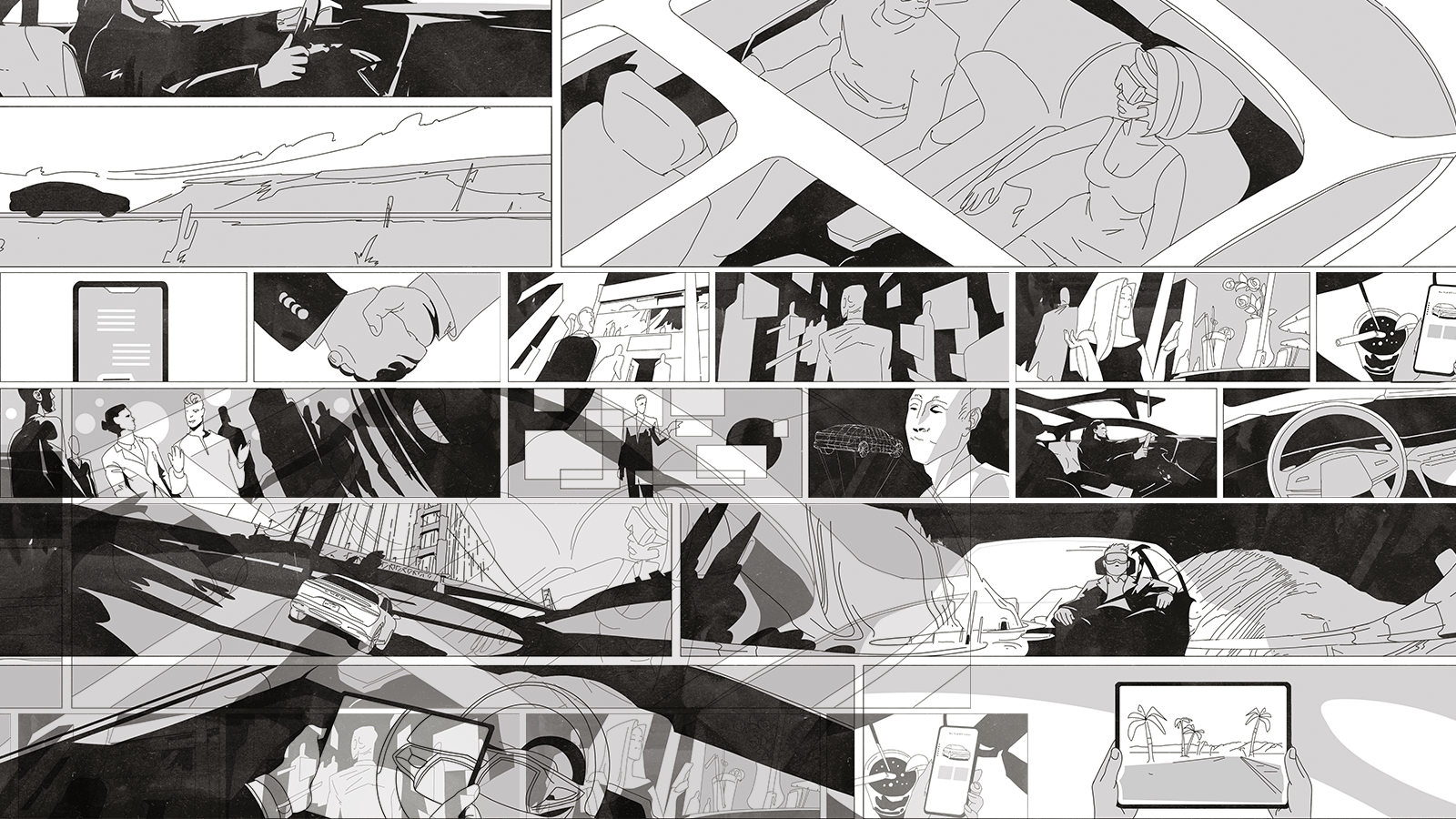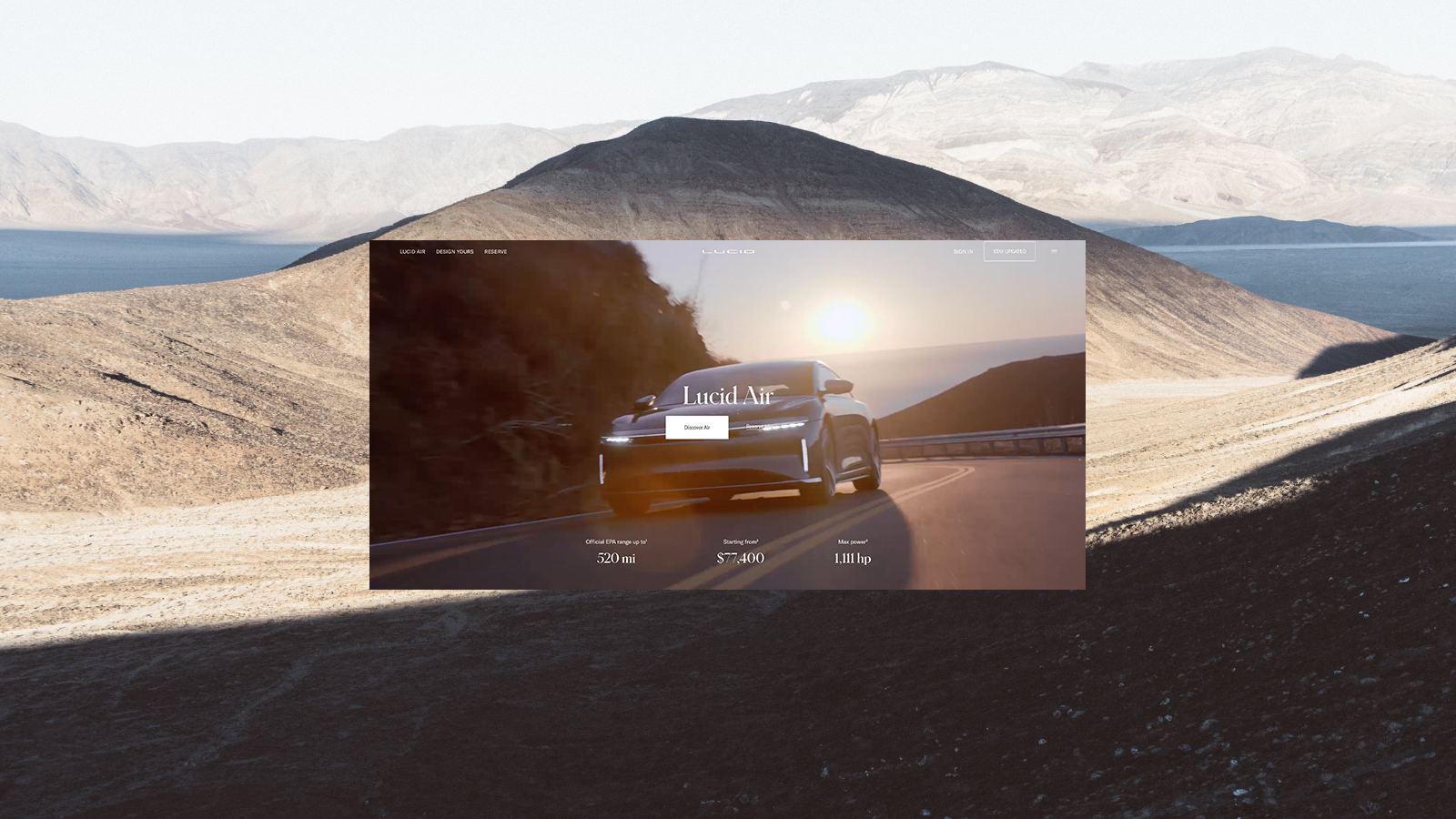Lucid Motors
Define an experience vision for the Lucid consumer digital touchpoints of the driver journey (from test drive to delivery and beyond). Infuse curated, branded EV driving “moments” with California lifestyle and environmental inspiration.

Company
Lucid Motors︎︎︎ builds powerful, long-range luxury electric vehicles with a focus on gorgeous craftsmanship and materials —inspired by California landscapes and sustainable, natural materials. Lucid sets itself far apart from any competitor through highly-curated driving and travel experiences.
Challenge
It was not only important to define the end-to-end (E2E) Lucid driver experience journey, but to gather teams that typically didn’t work together. This was challenging given geography and each of its many orgs having their own separate objectives. Bringing everyone into the same room fostered innovation, aligned everyone with goals and objectives, and infused the brand and its mission within every driver touchpoint in the ecosystem. It was no easy task to sew together the showroom experience, test drive and order experience, carefully define an integrated in-car and in-app experience. All of this would lay the groundwork for concierge-level delivery and exclusive, post-delivery community experiences.
Work Description
I led the work to define, prioritize, and systematize the integrated E2E driver experience journey. This considered digital, physical, print, person-to-person, environmental, and all possible experiential brand touchpoints. We began with thorough brand and product system and organizational audits, use case identification and sythensis, scenario development and establishing frameworks for journey touchpoints. These use cases and scenarios were clustered as sub-journeys or “moments,” and key moments where consdiered across the entire timeline from brand discovery to order to delivery and post-delivery. Note: a separate team worked in parallel to identify and propose technological depedencies, back-end infratsurtuce, data models, dev ops solutions (and more) for implementation.
All work in this case study honors confidentiality agreements and has been anonymized so that nothing proprietary is shared.
Results
We created an E2E journey of omni-media, omni-channel touchpoints that reinforced the uniqueness of the Lucid brand, lay the groundwork for integrated team execution of a consistent and premium digital ecosystem. We delivered “the playbook.” The Lucid brand lifestyle and its sustainability ethos was the “core” of every decision. Our final journey story and prototypes showed this through the eyes of a Lucid driver, and included a special “pay off”—simulating a surprise, actual physical experience for a team member.
Details
 Design Thinking Workshop/Use Case Identification and Prioritizing Journey “Moments” The combined team identified 603 use cases, and consolidated these into about 250 core, synthesized use cases. The core use cases were clustered together into “moments,” which numbered about 23 across 6 phases of the driver journey. The collaboration occurred at every leadership level of every org within Lucid, and teams throughout the week debated, clarified, argued respectfully and ultimately aligned around priortization of these moments. The consensus was unanimous, powerful, and excitement was palpable.
Design Thinking Workshop/Use Case Identification and Prioritizing Journey “Moments” The combined team identified 603 use cases, and consolidated these into about 250 core, synthesized use cases. The core use cases were clustered together into “moments,” which numbered about 23 across 6 phases of the driver journey. The collaboration occurred at every leadership level of every org within Lucid, and teams throughout the week debated, clarified, argued respectfully and ultimately aligned around priortization of these moments. The consensus was unanimous, powerful, and excitement was palpable.
Storytelling and Scenario Development As the “moments” were refined and clarified, we sketched rough storyboards for each, and then broke their touchpoints out by media type (digital-mobile app, digital-kiosk, in-person experience, etc.), and then created formal, professionally illustrated scenarios to more specifically bring light to phases of the Lucid driver journey. All of our scenario work was measured against the flow of “the story” and criteria for effective proposals was pressure tested against design principles, sustainability tenets, and adherence to the brand.
 Product Experience Journey Defintion: System Thinking/Business Design/Service Design As we moved from scenario development to concepts, we weren’t floating around in “blue sky” thinking without considering the technical or realistic implications of our decisions. We continuously vetted our ideas with various Lucid teams, engineering and dev ops teams and plotted these experiences visually, with details kept to a high level — but that every moment could be implemented and made real. In plotting specific journey experiences in this way, we maintained a system view, and made sure to balance attention to the user experiences that mattered the most.
Product Experience Journey Defintion: System Thinking/Business Design/Service Design As we moved from scenario development to concepts, we weren’t floating around in “blue sky” thinking without considering the technical or realistic implications of our decisions. We continuously vetted our ideas with various Lucid teams, engineering and dev ops teams and plotted these experiences visually, with details kept to a high level — but that every moment could be implemented and made real. In plotting specific journey experiences in this way, we maintained a system view, and made sure to balance attention to the user experiences that mattered the most.  Service Design Strategy: Making “Moments” Real As we drilled into each “moment” along the journey we defined which media the touchpoints included, which user needs and business objectives we were fulfilling, and cross referenced all these with technology implications and implementation proposals. We did not suggest anything we could not build or offer Lucid drivers in real life. The strategy of service design was one part innovation and one part grounding assessments in reality and feasibility.
Service Design Strategy: Making “Moments” Real As we drilled into each “moment” along the journey we defined which media the touchpoints included, which user needs and business objectives we were fulfilling, and cross referenced all these with technology implications and implementation proposals. We did not suggest anything we could not build or offer Lucid drivers in real life. The strategy of service design was one part innovation and one part grounding assessments in reality and feasibility.
Creating a Relationship With the Brand Before Ownership Lucid viewed the touchpoints prior to ownership as critical to the success of the journey. Part of this was our considering unexpected features and functions of key experiences in the Discovery phase of the journey as the prospective owner is getting to know the brand and vehicle models. We completely threw away conventional, expected thinking about these types of features, and re-oriented our intent to creating mesmerizing experiences that instead built a relationship with the brand early on. (Note: the above screenshot is symbolic of this point, and pulled from Lucid’s website in October 2021, showing the car configuator. This is work not executed within the scope of this case study.)

Cross-platform Service Design The above anonyminzed/redacted screen concepts are visually symbolic of our approach to “showing, not just telling” how seamless the journey for Lucid drivers must be. We focused on “any screen size on any platform” as a baseline best practice, knowing that people typically use a variety of devices in a variety of contexts (Eg. mobile apps vs. websites, tablets, desktop computers, and smartphones). Not only was our baseline best practices for cross-platform functionality and responsive web design, but that all essential features be made accessible anywhere, while device-specfic functions allowed for creative, ownable and unique experiences.

Visual Interaction Design Empowers the Brand A major emphasis of the project was tying the California landscape and lifestyle experiences within it to the needs of the audience segment. This meant “Essentialism” (or ONLY including essential features) often resulted in a “less is more” visual aesthetic with high emotional impact and two major interaction impacts: give people the exact information they need and provide the calls to actions the need to take to get what they want. The impact of this visual interaction was minimal, branded experiences with impactful calls to action. (Note: the above is a screenshot of the Lucid homepage in October 2021 and is symbolic of this aspect of the case study, and was not executed as part of in-scope work.)

Prototyping Rich “Blended” Experiences At the close of the project, we surprised a key Lucid stakeholder with a role play exercise realizing the connection between digital and phsyical touchpoints in a special way. We used them as our prospective driver, and walked through the entire journey of key touchpoint moments with them being our persona. We elevated beyond the expected digital-only presentation by showing a future state as if they were receiving a brand new, customized Lucid Air on delivery day—and (based on indicated interests) put together a surprise gift box. Complete with everything needed for a beautiful coastal California day trip (from sunscreen and picnic supplies to retail and culinary recommendations), the complete user journey was prototyped to simulate the unique nature of the Lucid experience. (Note: none of the brands nor services in the above gift box are official partnerships nor was this experience included in the scope of project work.)
Dramatic Result
The Lucid team applauded the above journey of brand touchpoints and its delivery as a playbook for the path ahead. While details have been made ambiguous to protect privacy, the feedback was overwhelmingly positive and the work as of 2021 is continuing to yield implementation and build-outs of real-life touchpoints.
Job & Role
Consulting Service Design Director
Participation
Strategy and Design Leadership, Faciliation of Multiple Design Thinking Workshops, and both hands-on and oversight of deliverables
Abilities
Brand Strategy, Sustainability Ethos Compliance, Sustainable Business Model Development, Service Blueprint Design, Storytelling, Use Case Definition, Research Synthesis, Scenario Development, Journeymapping, Journey Moment Design, System Thinking, Art Direction, Workshop Facilitation, Data and Workshop Output Synthesis, Insight Development, Competitive Research, Analysis and Synthesis, Opportunity Analysis, Prototyping, Brand Instinct Development, Visual Interaction Design, Experience Design, Environmental Design, HMI/HUD Concept Development, Responsive Web Design, Mobile App Design, Environmental Design, AR/VR/MR Concept Development